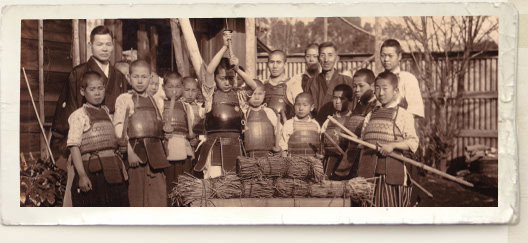
Old Bogu
In regards to the types of protective armour used in kenjutsu, Shimokawa states in Kendo no Hattatsu that in the Jikishinkage-ryu, Yamada Heizaemon Mitsunori (1639-1716) lamented the lack of spirit in many practitioners who concentrated only on kata training. He then started to devise a system of training that would allow practitioners to strike with full force without any danger of suffering or causing injury. His third son, Naganuma Shirozaemon Kunisato (1688-1767), completed the task between 1711-1716. I will use Shimokawa's theory as a base as I delve into the evolution of kenjustu bogu.
According to the Heiho Denki Chukai, a Jikishinkage-ryu manuscript, Yamada Heizaemon suffered a serious injury at the tender age of eighteen in a match conducted with bokuto. He stopped practicing kenjutsu until the age of thirty-two, when he was exposed to the teachings of the aforementioned Takahashi Danjozaemon's school where 'face mask and protective gauntlets were donned thus enabling one to engage in combat training without the risk of injury.' He wasted no time in becoming a student of this school, and it is recorded that by the time he was forty-six, he was awarded a license to teach (menkyo).
 This was 1684, but it is obvious that Takahashi Danjozaemon's school had been using bogu for a number of years already. However, this bogu only consisted of a facemask and gauntlets, but nothing resembling a do was employed. The Sagawa Shinkage-ryu, an associated school in the far north, employed only facemasks and gauntlets in their training. However, this indicates that all the related schools from the Shinkage-ryu line were making use of fukuro-shinai (prototype of modern shinai) as well as men and kote. In the drawing at right, taken from Suzuki Shozo's Sendai Fuzoku-shi (1927) we see a Shinkage-ryu adept using only a fukuro-shinai, men and kote. Thus, it states 'As the trunk was protected only by the thin material of the kimono that one was wearing, one learned the meaning of pain upon being hit in this rather vulnerable spot during keiko!'
This was 1684, but it is obvious that Takahashi Danjozaemon's school had been using bogu for a number of years already. However, this bogu only consisted of a facemask and gauntlets, but nothing resembling a do was employed. The Sagawa Shinkage-ryu, an associated school in the far north, employed only facemasks and gauntlets in their training. However, this indicates that all the related schools from the Shinkage-ryu line were making use of fukuro-shinai (prototype of modern shinai) as well as men and kote. In the drawing at right, taken from Suzuki Shozo's Sendai Fuzoku-shi (1927) we see a Shinkage-ryu adept using only a fukuro-shinai, men and kote. Thus, it states 'As the trunk was protected only by the thin material of the kimono that one was wearing, one learned the meaning of pain upon being hit in this rather vulnerable spot during keiko!'
Takahashi Danjozaemon's teacher Kamiya Denshinsai decreed that, 'When engaging in contest combat with other schools, always use a bokuto. The use of shinai is strictly prohibited.' He was a hardened kata advocate, and it wasn't until the era of Takahashi Danjozaemon that bogu came to be the norm rather than the exception.
In Yamada Heizaemon's text Heiho Zakki, he writes 'in order to really reach an understanding of mortal combat it is necessary for both adepts to don men, kote, and other pieces of protective equipment and forge oneself through the confusion encountered by engaging in daring unrestricted training.' This particular passage is referring to uchikomi-geiko, or training by actually striking with the shinai, something evidently promoted by Heizaemon in his latter years. Heizaemon died in 1716, the period that corresponds with Shimokawa's assertion that bogu was all but perfected by this stage.
In addition, the inscription on the gravestone of Yamada Heizaemon's third son Naganuma Shirozaemon Kunisato (1688-1767), the heir of the Jikishinkage-ryu tradition, states that his exploits included improving the bokuto and shinai, and refining the armour by adding a metal grill to the men and thick cotton protective coverings to the kote. Kunisato inherited the tradition from his father Heizaemon in 1708, and the two of them worked hard together to improve the bogu until Heizaemon's death.
Given these records, it is probably safe to conclude that the improvements of men and kote used in the Shinkage-ryu line of schools, and the addition of do to protect the trunk were the innovations of Yamada Heizemon and his son Naganuma Kunisato, particularly in the period 1711-1716.
The Bogu of Jikishinkage-ryu
Now that we have had a look at the process of bogu evolution in the Jikishinkage-ryu tradition, I shall turn our attention to what it actually looked like. Having said that, as far as I am aware, there are no original Jikishinkage-ryu sets of bogu left in existence. However, we can get a general idea from the illustrations contained in Tominaga Kengo's 1931 book Sho-Ryuha Budogu-Zue (Illustrations of Protective Armour from Various Martial Traditions)



By taking a close look at these illustrations we can surmise that the men was made of bamboo, and there is no protective covering for the throat (tsuki-dare). The do is made of flat bamboo slats strung together, the kote cover the whole forearm, and the shinai is a fukuro-shinai. If we compare these illustrations with the Shinkage-ryu armour in illustration 5, we notice a couple of the main differences are that the latter has no protective cotton padding on the top and that there is no do. The bogu depicted in illustrations 6-8 was probably not too dissimilar to the bogu developed by Naganuma Kunisato.
written
by Nakamura Tamio
translated by Alex Benett
Originally published on

This article has been published with the permission of Kendo World.
